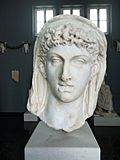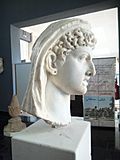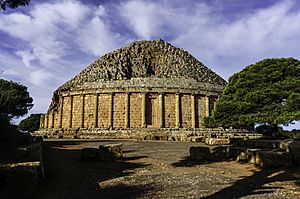Cleopatra Selene II facts for kids
Quick facts for kids Cleopatra Selene II |
|||||
|---|---|---|---|---|---|
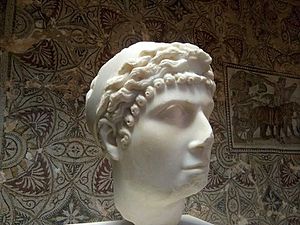
An ancient Roman bust of either Cleopatra Selene II, Queen of Mauretania, or her mother Cleopatra VII of Egypt: Archaeological Museum of Cherchell, Algeria
|
|||||
| Queen consort of Numidia | |||||
| Tenure | 25 BC – 25 BC | ||||
| Queen consort of Mauretania | |||||
| Tenure | 25 BC – 5 BC | ||||
| Born | 40 BC (presumed) Alexandria, Egypt |
||||
| Died | c. 5 BC Caesarea, Mauretania |
||||
| Burial | Royal Mausoleum of Mauretania | ||||
| Spouse | Juba II of Numidia | ||||
| Issue |
|
||||
|
|||||
| Father | Mark Antony | ||||
| Mother | Cleopatra VII Philopator | ||||
Cleopatra Selene II (Greek: Κλεοπάτρα Σελήνη; born around summer 40 BC – died around 5 BC) was an important princess from the Ptolemaic dynasty of Egypt. She was briefly Queen of Numidia in 25 BC and then Queen of Mauretania from 25 BC to 5 BC. She played a big role during the early years of the Roman Empire under Emperor Augustus.
Cleopatra Selene was the only daughter of the famous Greek Queen Cleopatra VII of Egypt and the powerful Roman leader Mark Antony. Her parents gave her control over lands like Cyrenaica and Libya. After her parents were defeated in a big war and died in Egypt in 30 BC, Selene and her brothers were taken to Rome. There, they were raised in the home of Octavia the Younger, who was the sister of Octavian (the future Emperor Augustus) and had been married to Selene's father.
Later, Selene married Juba II, who became King of Numidia and Mauretania. She had a lot of influence in Mauretania's government, especially with trade and building projects. During their time as rulers, the country became very rich. Selene and Juba had a son named Ptolemy of Mauretania, who later became king. Through their granddaughter, Drusilla, their family line connected with important Roman families for many generations.
Contents
Early Life of Cleopatra Selene II
Her Childhood in Egypt
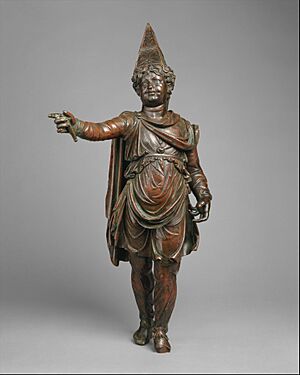
Cleopatra Selene was born in Egypt around 40 BC. She was the only daughter of Pharaoh Cleopatra VII. Her second name, "Selene," means "moon" in Ancient Greek. This was a contrast to her twin brother, Alexander Helios, whose name meant "sun." Selene grew up in Alexandria and received an excellent education, fit for a princess.
In 37 BC, her father, Mark Antony, officially recognized her and her twin brother. Their younger brother, Ptolemy Philadelphos, was born a year later. Their mother, Cleopatra, likely planned for Selene to marry her older half-brother Caesarion, who was thought to be the son of Julius Caesar.
Royal Gifts and a New Kingdom
Over the next two years, Antony gave a lot of land to Cleopatra and their children. In 34 BC, during a big public event in Alexandria, huge crowds watched as Antony and Cleopatra sat on golden thrones. Below them, Selene, Alexander Helios, and Ptolemy Philadelphus sat on smaller thrones.
Antony declared Cleopatra the "Queen of Kings." He also said that Caesarion was the true son of Julius Caesar and the King of Egypt. Then, he gave kingdoms to Selene and her brothers. Selene was made ruler of Cyrenaica and Libya. The children were too young to rule their lands right away, but their parents wanted them to do so in the future. This event, along with Antony's marriage to Cleopatra and his divorce from Octavian's sister, led to a major war in Rome.
War and Loss
In 31 BC, Antony and Cleopatra were defeated by Octavian in a naval battle at Actium. By the summer of 30 BC, when Octavian arrived in Egypt, the couple had sent their children away for safety. Caesarion tried to go to India, but he was caught by Roman forces and died. Selene, Alexander, and Ptolemy Philadelphos went south to Thebes.
Meanwhile, their parents died as Octavian's army took over Egypt. After their mother and Caesarion died, Selene and Alexander were briefly in charge of Egypt. However, the kingdom officially became part of the Roman Empire two weeks later.
Life in Rome
Octavian captured Selene and her brothers and took them to Rome. During his victory parade, he made the twins walk in heavy golden chains, dressed as the moon and the sun. Behind them was a statue of their mother holding a snake. The chains were so heavy that the children could not walk easily, and many Roman people felt sorry for them.
After Egypt became a Roman province, the question was what to do with Selene and her brothers. Since they had no other living relatives, Augustus (Octavian's new name) gave the children to his sister, Octavia. They grew up in her home on the Palatine Hill. Their extended family included their half-brother Iullus Antonius, their half-sisters (both named Antonia), and Octavia's older children. Between 26 and 20 BC, Cleopatra Selene was the only known living member of the Ptolemaic royal family. Her brothers are not mentioned in history after this time, and it is thought they may have died.
Marriage and Family
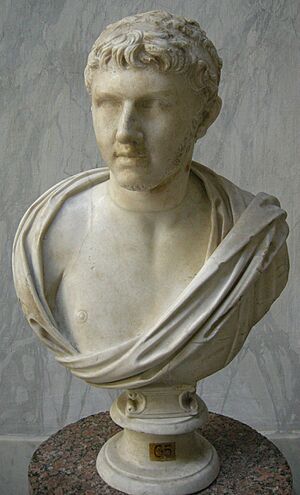
Octavia arranged for Cleopatra Selene to marry Juba II, an intelligent king from Numidia. Juba had also been raised in Rome. Their marriage likely happened in 25 BC. A poem written about their marriage still exists today:
Great neighboring regions of the world, which divides the Nile,
Swollen from black Ethiopia, divides,
You have created common kings for both through marriage, making one race of Egyptians and Libyans.
Let the children of Kings in turn hold from their fathers a strong rule over both lands.
Cleopatra Selene and Juba II had two children:
- Ptolemy of Mauretania, born around 10 BC. He was named after his mother's royal family and her younger brother. By choosing this name, Cleopatra showed her connection to her Egyptian heritage and her role as an heir to the Ptolemies, even though she was in exile.
- A daughter, whose name is not known, is mentioned in an ancient writing. Some historians think this might have been Drusilla of Mauretania, but she might have been a granddaughter through Ptolemy instead.
Some coins made by Selene have been found that date to 17 AD. It was thought she was alive to make them. However, historians generally believe that Juba would not have married a second wife, Princess Glaphyra, if Selene was still alive. It is possible that Selene and Juba separated for a time, but later got back together after Juba divorced Glaphyra.
Queen of Mauretania
In 25 BC, Emperor Augustus decided to make Juba II and Selene rulers of the new kingdom of Mauretania. This happened because Numidia, Juba's previous kingdom, became a direct part of the Roman Empire. The young rulers renamed their new capital Caesarea (which is modern Cherchell, Algeria) to honor the Emperor.
Mauretania was a very large area, but it needed to be organized. Cleopatra Selene is said to have had a great influence on the decisions Juba made for the kingdom. She brought many important advisors, scholars, and artists from her mother's royal court in Alexandria to work in Caesarea. Because of their leadership, the Mauretanian kingdom grew and became very successful.
Mauretania's Economy
Cleopatra Selene strongly supported trade in Mauretania. The kingdom developed a lot of trade with other regions around the Mediterranean Sea, especially with Spain and Italy. They sold products like fish, grapes, pearls, figs, grain, wooden furniture, and purple dye made from shellfish. Tingis (modern Tangier), a town near the Strait of Gibraltar, became a major trading center. The coins made in Mauretania were known for their value and quality throughout the Roman Empire.
Building Projects
Cleopatra's support for architecture showed a mix of Greek and Roman styles. The buildings and sculptures in Caesarea and Volubilis combined Ancient Egyptian, Greek, and Roman architectural designs. These buildings included a lighthouse similar to the famous Pharos of Alexandria in the harbor, a royal palace by the sea, and many temples dedicated to Roman and Egyptian gods. Her strong efforts to honor her mother's legacy were very different from the negative way Cleopatra VII was often shown in Roman writings at the time.
Her Death
Cleopatra Selene and Juba II ruled Mauretania for almost twenty years until Cleopatra died at the age of 35. There is some debate about the exact date of her death. A Greek poem by Crinagoras of Mytilene is believed to be a tribute to her:
The moon herself grew dark, rising at sunset,
Covering her suffering in the night,
Because she saw her beautiful namesake, Selene,
Breathless, descending to Hades,
With her she had had the beauty of her light in common,
And mingled her own darkness with her death.
If this poem describes a real event, Selene's death might have happened during a lunar eclipse. If so, looking at when lunar eclipses occurred can help guess the date. Eclipses happened in 9, 8, 5, and 1 BC, and in AD 3, 7, 10, 11, and 14. The eclipse in 5 BC seems to match the poem's description most closely. However, the exact date of her death is still not certain.
Selene was buried in the Royal Mausoleum of Mauretania in modern Algeria. This tomb was built by her and Juba east of Caesarea and can still be seen today. Juba died in 23 AD and was buried in the same tomb. There is a broken inscription dedicated to them as the "King and Queen of Mauretania." Their remains have not been found at the site, perhaps because the tomb was raided, or because it was meant to be a memorial rather than a burial place.
Her Legacy
Cleopatra Selene was survived by her husband and their son, Ptolemy. Ptolemy ruled Mauretania with his father until Juba's death in 23 AD. Ptolemy then ruled alone until 40 AD, when he was killed by Emperor Caligula. Caligula was Selene's great-nephew and was probably jealous of Mauretania's wealth. Caligula's successor, Emperor Claudius, took control of Mauretania since Ptolemy had no heirs. The kingdom was then divided into two Roman provinces. After this, Cleopatra, Juba, and Ptolemy were mostly forgotten by history.
One of the two satellites of the asteroid (216) Kleopatra was named Cleoselene in her honor.
In Fiction
- Cleopatra Selene is mentioned in the novels by Robert Graves, I, Claudius and Claudius the God.
- Cleopatra Selene is an important character in Wallace Breem's historical novel The Legate's Daughter (1974).
- Cleopatra's Daughter by Andrea Ashton (1979) tells about Cleopatra Selene's early life.
- The Memoirs of Cleopatra by Margaret George (1997) mentions Cleopatra Selene's birth and early life with her mother.
- Querida Alejandría by María García Esperón (2007) is a novel written as a letter from Cleopatra Selene to the people of Alexandria.
- Cleopatra's Daughter by Michelle Moran (2009) tells the story of Cleopatra Selene's early life, from her parents' deaths to her life in Rome and her marriage to Juba II.
- Lily of the Nile, Song of the Nile, and Daughters of the Nile, a trilogy by Stephanie Dray, tell Cleopatra Selene's life story with some fantasy elements.
- Cleopatra's Moon by Vicky Alvear Shecter (2011) is a novel for teens about Cleopatra Selene. The book ends with her marriage to Juba II.
- Cleopatra Selene and her twin Alexander appear briefly in the television series Rome.
- Selene, córka Kleopatry by Natalia Rolleczek is a novel about Cleopatra Selene and her brothers from their parents' deaths until her marriage.
- Selene is a main character in Michael Livingston's 2015 historical fantasy novel The Shards of Heaven.
- Cleopatra Selene is a major character in "The Daughters of Pallatine Hill," by Phyllis T. Smith (2016).
- A character named Patra, identified as the daughter of the famous Cleopatra, appears as a vampire in the third Night Huntress book.
See also
 In Spanish: Cleopatra Selene II para niños
In Spanish: Cleopatra Selene II para niños


